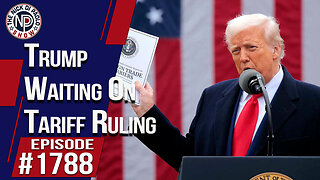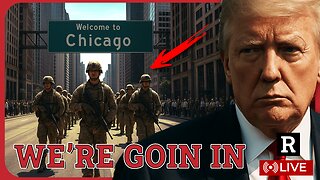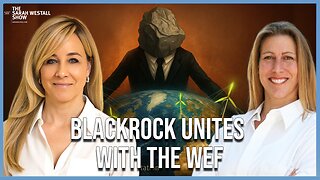Premium Only Content

John Nash and the Code of David
Title: “John Nash and the Code of David”
In the final years of his life, John Forbes Nash, the Nobel-winning mathematician and legendary codebreaker, began to obsess over something stranger than game theory, stranger even than the voices that once whispered CIA messages through radio static.
It started, like all divine obsessions, with a number: 91.
ACT I: The Soldier’s Psalm
In 1991, President George H.W. Bush, preparing for Operation Desert Storm, handed American troops a small laminated card. On it was Psalm 91 — the “Soldier’s Psalm.” A prayer of protection in the shadow of war:
“A thousand may fall at your side, ten thousand at your right hand, but it will not come near you…”
Bush called it spiritual armor. But Nash saw it differently.
“Psalm 91 in the year ’91... a shield,” Nash muttered in Princeton’s library, eyes red from sleepless nights.
“Operation Desert Shield.”
He scribbled a formula in the margins of a Gideon Bible.
P91 = (Y)(K)(Θ)
Y = Yahweh, K = Kuwait, Θ = the oil crown
ACT II: Psalm 92 and the Prize
The war officially ended in 1991, but Nash argued the real operation began the following year.
Psalm 92 — the year 1992.
It was a song of Thanksgiving, a Psalm of harvest and reward:
“The righteous will flourish like the palm tree… the wicked will be destroyed forever…”
To Nash, this wasn’t about trees—it was about fields. Oil fields.
He decoded the Hebrew acrostics:
“Black gold. Beneath the sands. Psalm 92. The reward.”
The math fit. The U.S. didn’t just push Saddam out of Kuwait—they consolidated control over Iraqi oil routes.
“Kick their ass, take their gas,” Nash said, eyes narrowing. “They weren't joking.”
ACT III: The Israel Code
But it wasn’t just about oil or soldiers. Nash believed the Book of Psalms held an encrypted timeline—a divine ledger encoded by King David, preserved by scribes, waiting for a mind like his.
He called it The Israel Code.
Each Psalm corresponded to a year in prophecy, starting from the founding of modern Israel in 1948. Psalm 48 = 1948.
Which meant:
Psalm 91 = 1991 → Operation Desert Shield
Psalm 92 = 1992 → The extraction begins
Psalm 93 = 1993 → Clinton and Oslo
Psalm 94 = 1994 → The Rabin assassination looms
...
Psalm 122 = 2022 → “Pray for the peace of Jerusalem…”
The alignment chilled Nash.
“David saw it all. The wars. The oil. The blood.”
He claimed Psalm 124 foresaw 9/11, describing “waters that would have engulfed us… torrents sweeping over us.”
But Psalm 139? That was the endgame. The mind of God exposed.
“If I rise on the wings of the dawn, if I settle on the far side of the sea, even there Your hand will guide me…”
To Nash, that was space colonization. Elon’s Mars dream. A final exodus.
*“Even in space,” he whispered, “the Lord is watching.”
EPILOGUE: What Are the Odds?
They found Nash’s final notebook after the crash that killed him and his wife. Scribbled in the margin of a psalm, circled in red:
“What are the odds?”
He had calculated the statistical improbability of the Psalms aligning perfectly with modern history:
1 in 365 trillion.
Some dismissed it as madness. Others called it divine math.
But in his final margin he wrote:
“Psalm 150. The last one. 2050. Everything that has breath... praise the Lord. It ends with a sound. A trumpet. Or a missile.”
No one knows if John Nash cracked the code completely.
But those who read the Psalms now do so with a calculator—and maybe a little fear.
-

Donald Trump Jr.
2 hours agoBuilding the Future with American Bitcoin, Plus Eric's Triggered Debut! | TRIGGERED Ep.272
25.5K46 -
 1:01:40
1:01:40
The Nick DiPaolo Show Channel
3 hours agoTrump Waiting On Tariff Ruling | The Nick Di Paolo Show #1788
5.77K14 -
 1:23:59
1:23:59
Dr. Drew
8 hours agoSalty Cracker: Dr. Drew's Birthday, Sydney Sweeney's Jeans, Rosie's Apology To MAGA & More News From Our Clown World – Ask Dr. Drew
76.9K30 -
 LIVE
LIVE
Rallied
1 hour agoWarzone Solo Challenges
86 watching -
 DVR
DVR
BonginoReport
2 hours agoMAHA Madness: RFK Jr. vs Newsom - Nightly Scroll w/ Hayley Caronia (Ep.127) - 09/04/2025
14.2K9 -
 1:58:36
1:58:36
Redacted News
3 hours agoUkraine bans Christians, Trump Sends Troops to Chicago, German AFD members being murdered | Redacted
98.9K76 -
 1:17:43
1:17:43
Michael Franzese
2 hours agoMy Daughters CONFRONTED Me About Being a Mobster Dad
16.5K1 -
 24:02
24:02
Kimberly Guilfoyle
5 hours agoCartel Strikes: Breaking News Coverage! | Ep.251
22.1K11 -
 1:01:36
1:01:36
Sarah Westall
2 hours agoBlackrock & the WEF Collaborate for World Dominance, Free Agency with AI w/ Reinette Senum
17.7K2 -
 3:08
3:08
Michael Heaver
13 hours agoOutraged UK Sends EMPHATIC Message
7.94K6